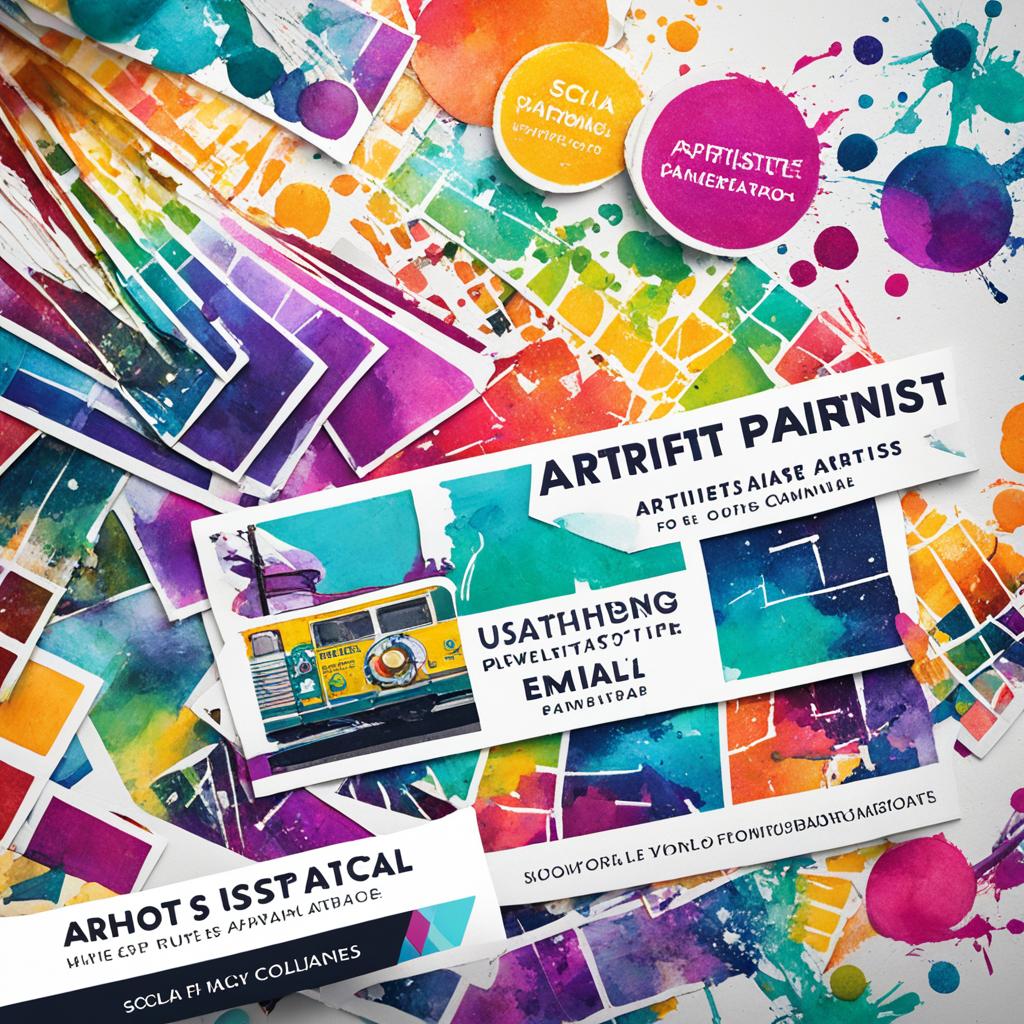If you’re an artist looking to make money, you’re in good company. Did you know the art market was big, worth $67.4 billion in 2019?*
It doesn’t matter if you’re a painter, illustrator, sculptor, or another kind of artist. Many ways exist to turn your art into cash. Selling your work, doing commissions, and growing a social media base are just the start. You can also start a YouTube channel, teach art classes, or use print-on-demand services to earn. This guide will help you learn how to profit from your art.
We’ll cover step-by-step strategies and tips for making money from your art. These methods can help you earn a steady income from what you love to do.
*pwc.com/us/en/audit-assurance/assets/global-art-markets-full-report-20.08.2020.pdf
Key Takeaways:
- Art market valued at $67.4 billion in 2019*
- Many ways to make money with your art
- Sell your art directly or online
- Offer custom art pieces
- Create a portfolio for freelance work
Sell Your Art Pieces
Selling your art is a great way to earn money from your creativity. It’s no matter if you are into painting, sculpture, or digital art. By selling your work, you can show your talent to more people. Here’s some advice on how to sell your art pieces:
1. Online Platforms
Use online marketplaces like Artsy, Saatchi Art, or Etsy. They let you share your art with buyers worldwide. Make sure your online profile looks good to attract fans and collectors.
2. Art Galleries
Think about showing your work in local art galleries. Choose galleries that match your style and audience. Galleries help make your art look more valuable. They let you put your pieces in shows and meet potential buyers.
3. Establish Your Own Website or Online Store
Create a website or online store to sell your art. This way, you control how your art is shown and sold. Build a site that’s easy to use, with great pictures and clear details. Use social media and work with other artists to get your site seen by more people.
4. Art Prints and Reproductions
Consider selling prints or copies of your art. This can make your work affordable for more people. Use companies like Printful or Fine Art America for quality prints, posters, or limited editions.
5. Digital Art
If you make digital art, there’s a big market for you. Sell copies or rights to use your art in digital projects. NFT marketplaces are a place to sell digital pieces and get noticed online.
Think carefully about how much to charge for your art. Consider your experience, demand for your work, and material costs. Always be ready to change your prices to stay competitive.
Online Platforms for Selling Art Pieces
| Platform | Features |
|---|---|
| Saatchi Art | Global marketplace for original artwork |
| Artsy | Connects artists, galleries, and collectors |
| Etsy | Handmade and unique products, including artwork |
| Fine Art America | Print-on-demand services for art prints |
In conclusion, selling your art is a key path to making money from your talent. Whether you sell online, in galleries, or on your site, think about your audience. Use digital art and prints to reach even more people. Remember, every piece you sell shares your creativity and helps your art career grow.
Take Commissions
As an artist, commissions are a great way to make money and show off your skills. By creating art that meets clients’ special requests, you can make pieces just for them. This lets you ask for more money and try out new styles and materials.
Starting with art commissions is simpler than it sounds. First, tell your friends, family, and online followers that you’re open for commissions. Explain how it works. This is a wonderful way to build up your portfolio and draw in more clients.
Remember, good communication is crucial for successful art commissions. Make sure to understand what your client wants, talk about their expectations, and listen to their feedback. This makes the process enjoyable for you and the client.
After finishing some commissions, collect feedback from happy clients. Their good words help show others you’re trustworthy. Put these testimonials on your website and social media. Doing this can encourage more people to ask for your art.
Building Your Commission Portfolio
A strong portfolio is key to show your skill and get new clients. Take clear photos of your commissions and put them together in a portfolio. You can have a physical book or an online gallery, whatever you prefer.
Make sure your portfolio shows off a range of your art. Include various styles and subjects to show what you can do. You might even organize it by commission type, like portraits or landscapes. This makes it easier for clients to see what they like.
Keep adding new works to your portfolio to keep it fresh. New additions show you’re improving and stay current. This is important for attracting clients.
Setting Commission Prices
Setting prices for your commissions can be tricky. Think about how complex the art is, its size, and the materials you used. Look at what others charge for similar work and consider your own experience.
Remember to value the time and effort you put into your art. Custom pieces take hard work and care, so price them fairly. You deserve to be paid well for your talent and time.
Offering different pricing packages can help meet various budgets and needs. You could have different prices for more detailed work, add services like framing, or offer unique rights to the art. This can attract a wider range of clients.
Build Your Portfolio for Freelance Gigs
As a freelance artist, a strong online portfolio is key. It shows off your skills, style, and work range. It helps clients see what you can do. To make a standout portfolio, follow these key steps.
1. Select Your Best Work
Pick your top artwork for your portfolio. Show different mediums, styles, and subjects. This way, clients see all you can do. It might lead to more freelance jobs.
2. Create a Professional Online Portfolio
Use online platforms made for art to build your portfolio. They have templates that make art look its best. Sites like Behance, Dribbble, and Adobe Portfolio are good choices. Also, make sure your website looks good and is easy to use.
3. Craft Engaging Portfolio Descriptions
E ach piece of art should have a short, interesting description. Talk about the idea, techniques used, and if it got any awards. These details help clients understand your art better.
4. Include Testimonials from Satisfied Clients
Client testimonials make your portfolio more trustworthy. Ask past clients if they can give you a testimonial. Put these reviews in a visible spot to boost your image as a great freelance artist.
Working with [Client Name] was an absolute pleasure. [They/She/He] understood my creative vision and delivered exceptional results that exceeded my expectations. I highly recommend [Artist Name] for any artistic project. – [Testimonial Source]
5. Incorporate a Variety of Artwork
Show sketches, ongoing work, and concept art too. This shows your creative process. It lets clients see the effort and care you put into your work.
6. Ensure Consistency and Cohesion
Your portfolio should look unified. Sort your art into groups or series. Make sure the style, colors, and setup look professional and together.
7. Update Regularly
Keep adding new and current art to your portfolio. This shows you’re growing as an artist. Also, take out old or less fitting pieces to keep your portfolio fresh and relevant.
By doing these things, you’ll make a great online portfolio. It will show your talent and help you get freelance art jobs. Remember, your portfolio is your brand. It’s how you’ll find exciting art opportunities.
Please note that the image above serves as a visual representation and does not necessarily reflect the actual artworks found in the portfolio.
Grow a Social Media Following
Social media lets artists show their work to the world. Sites like Instagram, Facebook, and Twitter are great for sharing art. They help artists connect with fans and find new clients. Here are some tips to get more followers:
1. Create Engaging Content
Post pictures that catch the eye. Use good quality images to show your art. Add stories about your work to connect with people.
2. Post Regularly and Consistently
Posting often is important. Make a schedule and stick to it. Share new art or sneak peeks to keep followers interested.
3. Utilize Relevant Hashtags
Hashtags help more people find your art. Use popular ones like #art and #artist. This gets your work seen by more people.
4. Collaborate with Other Artists
Working with other artists can get you more followers. Do projects together or share each other’s work. This helps everyone get more attention.
5. Engage with Your Followers
Talking to your followers is important. Answer their comments and thank them. Being friendly makes your followers loyal.
6. Explore Artist-driven Online Communities
Join groups for artists online. These communities offer more chances to show your art. And you can meet other artists.
7. Optimize Your Social Media Profiles
Make your profiles look good. Use a clear picture and write a catchy bio. Add links to your website or portfolio.
8. Track Your Performance and Adjust
Check your social media stats to learn what works. Focus on what gets likes and comments. Then, make more content like that.
9. Cross-Promote on Multiple Platforms
Share your art on different sites. Link your social media profiles on your website. This helps more people see your work.
Follow these tips with real effort, and you’ll build a following. This network will support your art and might buy it or collaborate with you.
Start a YouTube Channel
Are you an artist wanting to reach more people and make money from your work? Starting a YouTube channel for your art is a smart move. YouTube lets artists show their creativity to the world. You can post videos teaching art, share tips, recommend supplies, and connect with your audience.
Posting videos regularly can help you get a group of fans who love your work. These supporters can offer feedback and inspiration. This helps you grow as an artist.
Another perk of YouTube is making money from your videos. You can earn through ads, sponsorships, and selling merchandise as your channel grows. This income is in addition to what you make from selling art. It can help you stay financially stable while you share your creativity.
“Starting my own YouTube channel has been a game-changer for me as an artist. Not only has it allowed me to connect with a wider audience and share my knowledge, but it has also opened up new opportunities for collaborations and sponsorships. Plus, the income from YouTube ads definitely helps support my artistic pursuits!” – [Your Name]
To make a successful YouTube channel, you need a good plan. Here are some tips to start:
1. Choose a Niche
Pick a specific part of the art world to focus on. This could be painting, digital work, sketching, or art journaling. Find what makes your channel unique and stick with it.
2. Plan Your Content
Make a schedule for your posts to keep content coming regularly. Plan your videos ahead of time. Think about making video series or themed content to keep viewers interested. Include tutorials, share your creative process, and suggest good art supplies.
3. Engage with Your Viewers
Answer comments, talk to your viewers, and get them involved in discussions. Creating a community around your channel makes your audience feel connected to you. This increases support and views.
4. Collaborate with Other Artists
Working with other artists can get your channel seen by more people. You could do art challenges together, make joint tutorials, or feature each other’s work. Collaboration helps everyone involved and creates a sense of community.
5. Promote Your Channel
Use social media like Instagram, Facebook, and Twitter to promote your channel. Share video previews, behind-the-scenes looks, and news about upcoming posts to attract new followers.
Remember, making a YouTube channel successful takes effort and time. Keep posting consistently, improve your videos, and listen to your viewers. With hard work and passion, your channel can be a great place to share your art with the world.
Develop an Art Course
As an artist, I believe it’s great to share knowledge through art courses. You can use platforms like Udemy or your website. This way, you can teach art online to many.
Taking your courses online means students from everywhere can learn with you. You get to help them grow and find their creative voice. It’s rewarding to see them develop their style.
Think about who you’re teaching. Your courses should match their skill level. Make tough concepts easy. This makes learning fun.
Use different ways to teach, like videos and exercises. This helps students learn better. They can practice what they learn in real-time.
Why Choose Online Art Courses
Online teaching lets you reach many students. You control your content and schedule. You also get to teach students worldwide.
Students love online courses because they fit into their lives easily. They learn from home when they want. Plus, they meet other artists online.
Creating a Successful Art Course
Think about these key parts when making your course:
- Course Structure: Organize your content well. Make sure each part builds on the last. Tell students what they’ll learn.
- Engaging Content: Use different media to keep things interesting. Include examples and exercises. This helps students understand better.
- Student Support and Feedback: Let students ask questions and get feedback. Encourage them to take part and support each other.
- Marketing and Promotion: Use social media and your site to tell people about your course. Show what students say to gain trust.
- Continuous Improvement: Update your course with new ideas and student suggestions. Keep up with art trends and technologies.
By making an art course, you’re not just sharing art. You’re helping artists grow. Be their mentor and guide. It’s a rewarding career.
Pros and Cons of Online Art Courses
| Pros | Cons |
|---|---|
| Flexibility to create and deliver content at your own pace | Lack of in-person interaction and immediate feedback |
| Ability to reach a wide audience globally | Effective time management required for course creation and promotion |
| Convenience for students to learn at their own pace | Technical challenges for both teachers and students |
| Opportunity to develop a supportive online community | Heavy competition in the online art education market |
Developing online art courses is exciting for teachers and students. You get to teach your craft and inspire. Plus, you can earn money. Dive into teaching art online.
Sell Through Print on Demand Platforms
Looking to make money from your art with ease? Print-on-demand platforms are great for this. Sites like Society6 and Redbubble let you sell art prints and more. You won’t have to deal with making, shipping, or customer service.
With these services, turn your art into things like prints, shirts, and phone cases. Just upload your designs, and they handle everything else. This lets you keep making and sharing your art.
There are many benefits to using print-on-demand. You can reach lots of people since these sites have many customers. This means more folks might find and buy your art.
Plus, these platforms do all the sale work, from making products to shipping them. So, you don’t need to keep products in stock or send orders yourself. Focus on your art and let them do the rest.
You get paid a part of each sale, too. This means earning money from your designs over time. It’s a good way to get steady income from what you create.
Advantages of Selling Through Print-on-Demand Platforms:
- Reach more people and sell more.
- Save time and effort by not handling products or orders.
- Earn money from each sale for ongoing income.
- Make various products with no need to deal with making or shipping.
Want to start selling this way? Here are two great choices:
Society6
Society6 is a top choice for selling art prints, decor, and more. It’s easy to use for listing your designs. On Society6, your art can reach people worldwide. You earn royalties from sales.
Redbubble
Redbubble is another top option for artists. It offers many customizable products, from clothes to tech gear. On Redbubble, set your prices and pick product options. You earn from each thing sold.
Using sites like Society6 and Redbubble helps grow your art’s reach. You can put your work on many products and make money. It’s a smart move, whether you’re new or experienced in art.
| Print-on-Demand Platform | Advantages |
|---|---|
| Society6 |
|
| Redbubble |
|
Become an Affiliate Partner
If you love art and want to make some extra money, think about becoming an affiliate partner. This is a great way to make money by promoting art supplies or products. You get a commission for each item sold through your link.
Join art supply affiliate programs to find awesome art supplies. You can share these with your fans. Whether it’s brushes, paint, canvases, or other essentials, you can earn by referring sales.
It’s important to share products you truly like. This builds trust with your followers. You’ll be seen as a go-to for art supply tips.
You can add your recommendations to your posts or tutorials. Mention the art supplies you use and share your affiliate links. This lets fans buy them easily.
Or, you can review art products in detail. Talk about what’s great about them and your own experiences. This helps your followers decide what to buy. You earn a commission for each sale.
You can also work with art brands for special deals. This can encourage more people to buy through your links.
To make money, you need to share your links often. Use your site, social media, emails, or YouTube to talk about them. This helps you sell more.
Art supply affiliate programs let you help your followers find great supplies. You earn money, and they get to be creative. It’s good for everyone.

Sell at Art Fairs
Art fairs are great for artists like me to show and sell art. We can rent a booth or table at local fairs, shows, or conventions. This way, I can show my work and meet potential buyers and art fans.
These fairs let me meet visitors and network with other artists. I can learn from them and get new ideas. The lively environment helps me feel part of a community. I also get to connect with people who love art.
I make my booth inviting to draw people’s attention. I display my art in a way that shows its quality and range. Whether it’s paintings, sculptures, or mixed media, I make sure they look their best.
Talking to people at the fairs is very important. I love to share what inspires me and the stories behind my art. This helps me connect with art lovers. It can also lead to sales and chances to work together in the future.
Art fairs can mean big sales because they draw people who love art. By talking to buyers, I learn what they like. This helps me improve my art and sell more. It’s a great way to see what’s popular and change my art to fit.
Being at art fairs helps me sell my art right away. I also meet new people and might get chances for shows or special projects later. It helps me be known in the art world and build my reputation.
Utilize Instagram’s Shop Tool
If you’re an artist, Instagram’s shop tool can help. It lets you sell your art to more people. Here’s how to use it right:
1. Create a business account: First, change your account to a business one. This connects your profile to your Facebook page. It also gives you access to business tools.
2. Upload high-quality images of your art: Good photos are key on Instagram. Make sure your art looks its best. High-quality images will catch potential buyers’ eyes.
3. Utilize Instagram’s shopping features: You can tag your artwork in posts and stories. This makes it easy for people to buy your art. Just a few taps and they can purchase directly.
4. Engage with your followers: Talk to your followers to build a community. Answer their questions and thank them. This helps create a loyal fan base.
5. Use relevant hashtags: Hashtags make your art easier to find. Use ones that match your style and audience. They help your art show up in search results.
6. Promote your artwork: Besides the shop tool, post regularly. Work with other artists and run promotions. Special deals and giveaways can attract more buyers.
Instagram’s shop tool can showcase your art to many. With focus and effort, it can be a great way to earn from your art.
Open an Etsy Store for Your Art
If you’re an artist, Etsy is a great online place to sell your art. It’s known for unique, handmade products, including artwork. An Etsy store lets you reach people all over the world.
When starting your store, focus on showing your art well. Use high-quality images that make your work stand out. Good photos can really draw in buyers.
Write clear, detailed descriptions for your art. Mention the size, medium, and anything else buyers should know. Always be honest about your art’s condition. Sharing the story behind your piece can also attract buyers.
Use the right keywords in your store to help people find you. Think about what art buyers might search for on Etsy. Adding these keywords can help more people discover your art.
Etsy has tools to help you share your work with more people. Join Etsy sales, offer deals, and talk to the Etsy community. These steps can help you reach a wider audience.
Keeping your store up-to-date is important. Add new art often and quickly answer customer questions. Being active and reliable makes customers want to come back.
Having an Etsy store lets you share and sell your art to the world. Use Etsy to make money, meet art lovers, and grow your career in art.
Benefits of Opening an Etsy Store for Your Art
- Access to a global audience of art enthusiasts
- Opportunity to monetize your artwork
- Built-in promotional tools and features to increase visibility
- Etsy’s trusted and secure platform for transactions
- Potential for repeat customers and loyal followers
License Your Artwork
As an artist, you can make money while you sleep by licensing your artwork. This means letting others use your art for a fee. It’s a way to make extra cash and share your art with more people.
Your art could end up on many things, like products or ads. It’s a chance for your work to shine in new ways. Companies might want your art for their unique designs.
Think about working with print-on-demand services. They pair up artists with makers. This helps you sell your art globally without worrying about stock or shipping.
| Licensing Artwork Benefits | Considerations |
|---|---|
| 1. Passive income from licensing fees or royalties | 1. Ensure contracts protect your rights as the artist |
| 2. Reach a wider audience and gain exposure | 2. Research potential licensing partners to ensure they align with your brand and values |
| 3. Leverage the expertise and manufacturing capabilities of print-on-demand services | 3. Understand the terms and restrictions associated with each licensing agreement |
Print-on-Demand Licensing
Platforms like Society6 and Redbubble let artists license their art. They handle making, shipping, and customer service. This lets you focus on your art and licensing it.
Listing your art on these platforms gets it seen worldwide. People can buy products with your designs. You get part of the sale.
It’s key to know the details of print-on-demand contracts. Learn about any exclusive deals, how you get paid, and your share of sales.
Make sure your art rights are secured. Talk about what the platform can do with your art. Setting limits helps protect your work and meet your needs.
Licensing Agreements with Companies
You can also license your art to companies. This could be with clothing brands or home decor firms. And even ad agencies.
Look into companies that fit your art and values. Choose those known for quality and fairness. This helps your art stay true to you.
When you agree to a deal, get a contract that safeguards your art. Talk about how long the deal lasts, where your art goes, and how you’ll be paid. This keeps your rights protected.
Licensing lets your art reach far and wide. It’s a chance to earn more and share more. Try licensing through platforms or with companies and see your art go places.
Conclusion
There are many ways for artists to make money and share their work. By using a mix of methods and platforms, they can make their art pay off.
Artists can sell their pieces, do commissions, grow their online presence, launch a YouTube channel, and use print-on-demand and affiliate links. Success means being active, marketing well, and keeping in touch with fans.
To make it in the art world, artists need to keep working hard and being smart. Always stay true to what you love making. Keep improving your craft and take every chance to share and sell your art.
FAQ
How can I make money with art?
How do I sell my art pieces?
Can I make money by taking art commissions?
How can I build my portfolio for freelance gigs?
How can social media help me as an artist?
How can starting a YouTube channel benefit artists?
Can I make money by offering art courses?
How can I sell my art through print-on-demand platforms?
How can I become an affiliate partner as an artist?
How can participating in art fairs help me sell my art?
Can I sell my art on Instagram?
How can I sell my art on Etsy?
Can I license my artwork?
How can I summarize the steps to make money with art?
Source Links
- https://www.darkyellowdot.com/make-money-as-an-artist/
- https://novacolorpaint.com/blogs/nova-color/make-money-as-an-artist
- https://printify.com/blog/how-to-make-money-as-an-artist/
Money posts:
 How to Become a Freelance Artist in 2024
How to Become a Freelance Artist in 2024
 Building A Successful Freelance Makeup Artist Business (2024)
Building A Successful Freelance Makeup Artist Business (2024)
 How To Make Money On Soundcloud: Step-by-Step Guide (2024)
How To Make Money On Soundcloud: Step-by-Step Guide (2024)
 How To Create A Successful Youtube Channel On A Budget (2024)
How To Create A Successful Youtube Channel On A Budget (2024)
 How To Sell Your Digital Art As Nfts For Beginners (2024)
How To Sell Your Digital Art As Nfts For Beginners (2024)
 How To Start A Successful Youtube Gaming Channel (2024)
How To Start A Successful Youtube Gaming Channel (2024)
 How To Make Money On Youtube Without Making Videos: Step-by-Step Guide (2024)
How To Make Money On Youtube Without Making Videos: Step-by-Step Guide (2024)
 How to Create a YouTube Channel and Make Money
How to Create a YouTube Channel and Make Money

